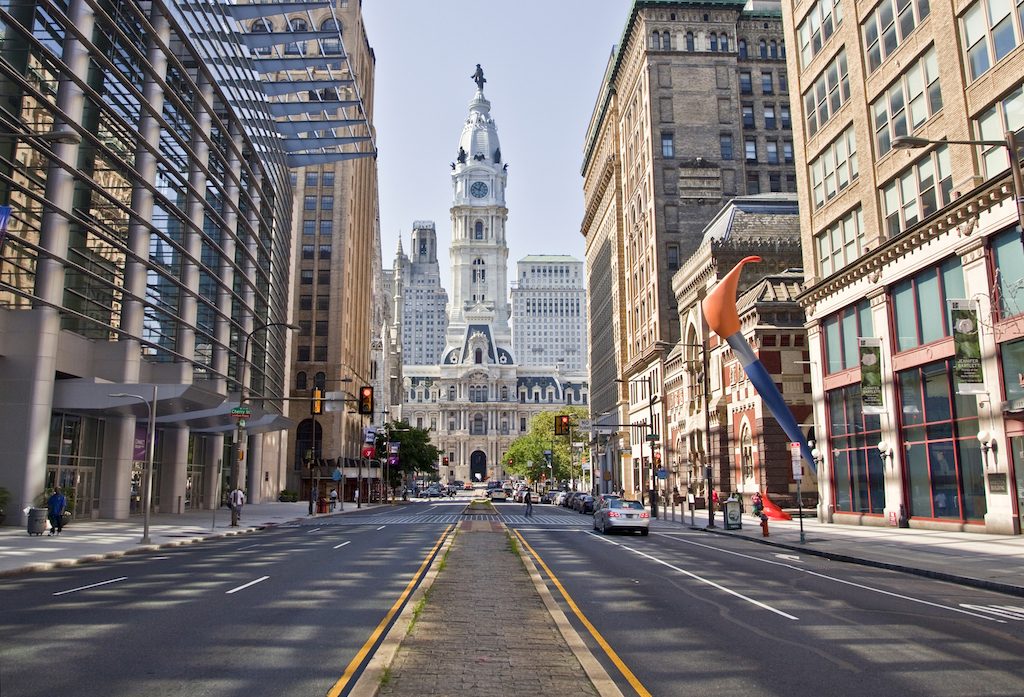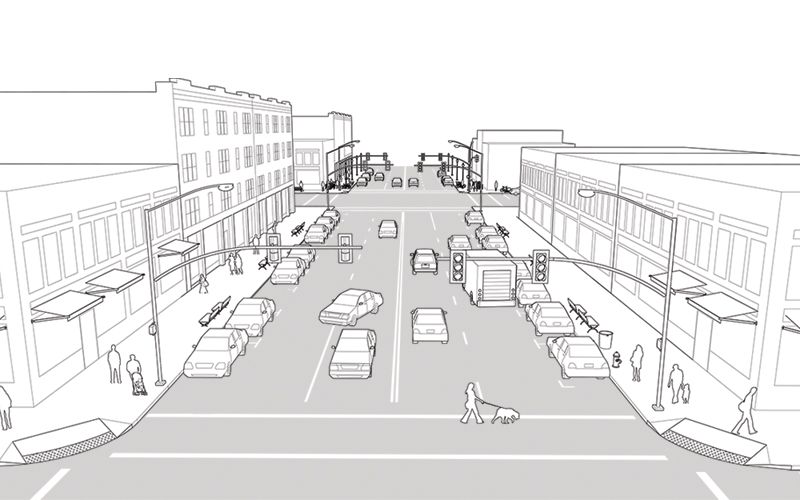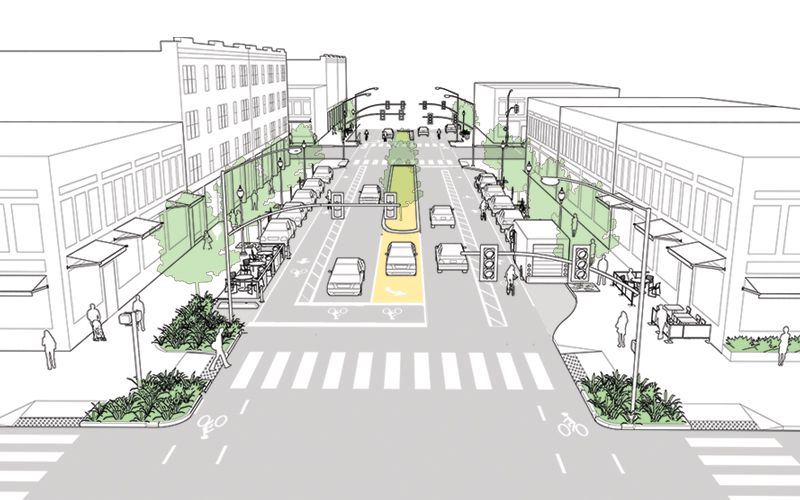People spend more money when cities are less vehicle-oriented.

You’ve probably seen the term “walkability” thrown around in relation to cities, neighborhoods, and even apartments. A city’s walkability, per Walk Score, is determined by analyzing how many errands can be done without a car, and cities with the highest scores (like Boston, New York, and San Francisco) often come with an incredibly steep cost of living.
On Walk Score’s one to 100 scale that evaluates cities with a population of 200,000 or more,New York City is the most walkable city in the country with a score of 89, and Fayetteville, North Carolina, is the least walkable with a score of 29. The average walk score of all American cities with a population of over 200,000 is 49.
Walkability is treated as a static part of a city; your city is either walkable or not. You either need a car or you don’t. But a city’s walkability is dynamic and can be improved with people-oriented city planning, which will benefit the local economy and make societies more equitable.
From our partners:
Walkability is great for the economy
American city planner Jeff Speck has been advocating for walkability for the past 25 years, and in his new book, Walkability City Rules: 101 Steps to Making Better Places, he carefully outlines how to “sell” walkability and then implement it.
The idea is marketed based on a few big benefits, according to Speck’s book, one of them being economics. Cities with high walk scores also have high property values. According to a 2009 study, each additional walk score point resulted in home values increasing between $500 and $3,000.
Investing in walkable cities, whether through allocating funds to repaint pedestrian walkways or building affordable housing close to downtowns, also attracts diverse populations and creates jobs. According to the Chicago Metropolitan Agency for Planning, 63 percent of millennials and 42 percent of boomers would like to live in a place where they don’t need a car. And according to the National Association of Realtors, 62 percent of millennials prefer to live in a walkable community where a car is optional. If cities seem less automobile-dependent, chances are they are more appealing to a range of ages.
Walking also costs the city very little, unlike cars and even public transit. According to Speck’s book, if a resident takes a bus ride, it may cost them $1 but costs the city $1.50 in bus operation. If a resident decides to drive, it costs the city $9.20 in services like policing and ambulances. When a resident walks, the cost to the city is a penny.
People also tend to spend more money in walkable cities, stimulating the local economy. A 2008 report of San Francisco’s downtown found that public transit users and walkers spent less on each trip downtown but made more frequent trips, which meant they spent more money overall. Those in cars spent more money on one trip but frequented downtown less.
This aligns with the concept of people-oriented streets, the urban planning practice of making roads safe to cross and filled with amenities people need (restaurants, banks, salons etc.). Many streets in America, especially in areas of suburban sprawl, are vehicle-oriented, don’t have sidewalks, and are not accessible without a car.
Even though the United States is a car-centric society, one-third of Americans don’t have a license, and according to a government census, a majority of those who walk to work make under $50,000.
“The most common condition is the poor person who can afford a car but it totally disrupts their finances,” Speck told me. “The unfortunate circumstance is that most Americans live in places where car ownership is mandatory.”
Walkability doesn’t have to mean gentrification
With talk of home prices going up and walkability attracting more people, walkability can read as a recipe for displacement. Take Oakland, California, for example. When San Francisco become too pricey and people were looking for a more affordable alternative, nearby Oakland was an appealing option. But while the influx of people spurred new development and increased walkability, it also hiked the cost of living; now the average rent for an apartment in Oakland is $2,926, compared to $1,695 in 2011.
But Speck says walkability can actually work to make communities more equitable. According to his book, cities with more transit choice demonstrate less income inequality and less overspending on rent. Walkability opens up the world to the elderly, who often struggle to find transportation when they lose the ability to drive, and public transit is used most by minorities and those making under $50,000. Since transit and walking go hand in hand, improving the walkability of a city could help better serve those in lower income brackets.
“For the typical city where most Americans live, there’s very little risk of improved walkability causing gentrification,” he told Vox, “particularity in the short term, just because [cities] have so far to go just to reach a modicum of safety and comfort.”
How cities can become more walkable


Though he’s been preaching the walking gospel for years, Speck says the message has only recently caught on. “In the ’80s, no one got it,” he said. “In the ’90s, developers started to get it. In the aughts, the cities got it. And now I’m finally seeing in this decade that the engineers are starting to get it. Our biggest impediment [in developing walkable cities] was the public works folks and engineers who weren’t letting us do things right.”
The National Association of City Transportation (NACTO)’s executive director, Linda Bailey, says that in years past, the national city planning standard addressed people walking as an afterthought, which is why NACTO builds design guides to direct cities on how to become more pedestrian-friendly. Guides outline a number of transformations including how to turn a heavy-traffic two-way street into a “neighborhood main street” with bike lanes, sidewalks, and greenery.
Cities that have been notably increasing their walkability include Washington, DC, and Seattle, where city planners started dedicating space on the edges of roads to pedestrians and calling them “walkways” as opposed to sidewalks.

This may have been helpful in the 19th century when homes needed to be far away from factories emitting toxic fumes, but today it makes less sense. The solution: Cities should adopt regulations that allow land to be multi-use, such as in the mixed-use developments that dot the sprawling landscape of many American suburbs and cities.
In Plano, Texas, the Legacy Town Center features shops, apartments, a movie theater, and restaurants in a pedestrian-friendly smattering of urbanism. The city of Tampa is constructing Water Street Tampa — a $3 billion development that will include shops, entertainment, residences, and offices.
Bailey says mixed-use developments are attractive to developers because they present an opportunity to experience what it could have been like to plan a city 50 or 80 years ago. “Really, they’re trying to recreate what cities like Philadelphia have always had,” she says. (With a walk score of 79, Philly is the fifth most walkable city in America.)
Other steps in Speck’s book include pushing for local parks and schools, both of which foster community and ownership of a neighborhood. He also says that cities need to invest in attainable housing downtown so they don’t get overrun with the wealthy.
“An extreme example [of wealth in walkable cities] is this kind of jack-o’-lantern effect, where many homes are owned by people who own five homes and if they are distributing their time between these homes evenly, most of the time a house is empty, so you get this weird condition of the extremely dense ghost town, which is the worst,” Speck says.
There are also more simple tasks like reallocating road space to accommodate bikes or creating street parking so people can drive to a city, park, and then walk around and enjoy. “Restriping a too-fast street to include a bike lane, or turning a row of parallel parking spaces into angled parking, these things can be done for the price of paint,” Speck tells Vox. “If a street needs resurfacing anyway as part of its regular maintenance, the changes can be done for free.”
Whatever method, walkability is a spectrum, and implementing positive change that gets people to drive their car less is better for the economy and the environment. “The more we can walk, bike, and take transit, we’re spending a lot less than the alternative, which is to drag around a two-ton carcass of steel that belches climate change,” Speck says.
This article is written by















